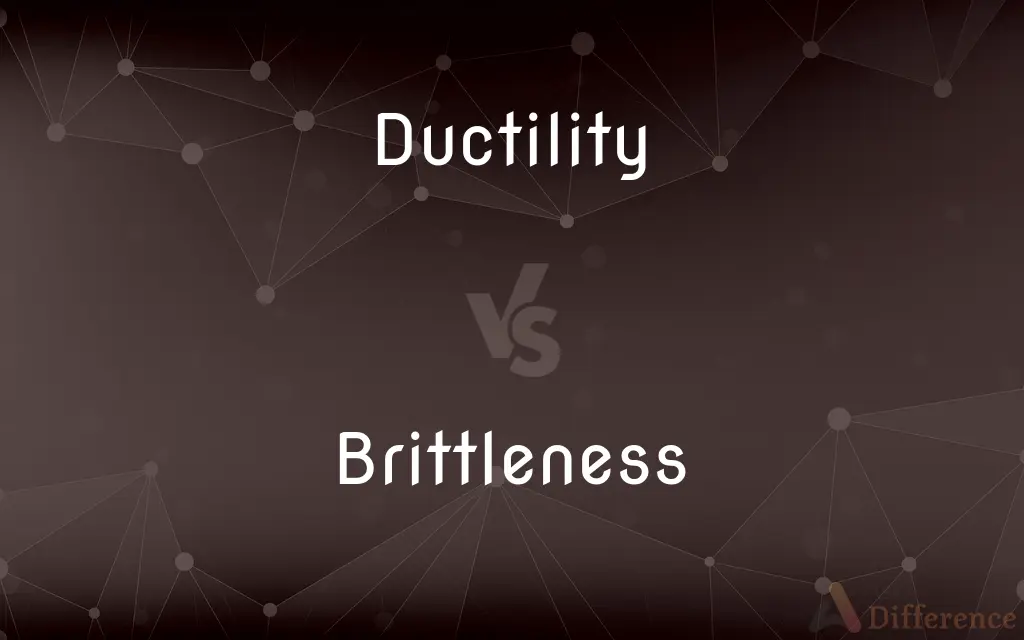Ductility vs. Brittleness — What's the Difference?
By Tayyaba Rehman & Maham Liaqat — Updated on March 13, 2024
Ductility refers to a material's ability to deform under stress, typically stretching into a wire, while brittleness describes a material's tendency to fracture without significant deformation.

Difference Between Ductility and Brittleness
Table of Contents
ADVERTISEMENT
Key Differences
Ductility characterizes materials that can undergo significant deformation before failure, often seen in metals like copper and aluminum, which can be drawn into thin wires or bent into various shapes without breaking. On the other hand, brittleness is a property of materials that fracture under stress without noticeable plastic deformation, such as glass and some ceramics, which shatter when subjected to impact.
Materials with high ductility, such as gold, can absorb considerable energy before failure, making them ideal for applications where flexibility and resilience are critical, like electrical wiring and structural components that must endure bending and stretching. Conversely, brittle materials, while often very hard and strong under compression, have limited applications in scenarios requiring impact resistance or flexibility, as they are prone to sudden failure when subjected to tensile stresses.
The ductility of a material is quantified by its ability to stretch into a wire, with measurements such as percentage elongation and reduction in area in tensile tests providing insights into its ductile properties. In contrast, brittleness does not have a direct quantitative measure but is often inferred from the lack of plastic deformation and the material's failure mode, typically assessed through impact tests like the Charpy or Izod tests.
Environmental and operational conditions, such as temperature, can significantly influence the ductility and brittleness of materials. Metals may become more brittle at low temperatures, leading to brittle fracture, while some materials might exhibit increased ductility at higher temperatures, making them more malleable and easier to shape.
Understanding the distinction between ductility and brittleness is crucial in material selection for engineering applications, ensuring that materials are chosen that will perform reliably under expected stresses and environmental conditions, avoiding catastrophic failures in structures and components.
ADVERTISEMENT
Comparison Chart
Definition
Ability to deform under tensile stress, often stretching into a wire.
Tendency to fracture under stress without significant deformation.
Characteristic Materials
Metals like copper, aluminum, and gold.
Glass, ceramics, and some hard metals.
Energy Absorption
High, can absorb considerable energy before failure.
Low, fractures suddenly under stress with minimal energy absorption.
Applications
Electrical wiring, structural components requiring flexibility.
Applications where high strength and hardness are needed but flexibility is not critical.
Quantification
Measured by percentage elongation and reduction in area.
Inferred from the lack of plastic deformation and failure mode.
Compare with Definitions
Ductility
Ductility allows materials to be drawn into wires.
Copper's ductility makes it ideal for electrical wires.
Brittleness
Brittle materials break without significant deformation.
Glass shatters easily upon impact due to its brittleness.
Ductility
Ductile materials offer resilience in dynamic environments.
Ductile pipes can flex under load, reducing the risk of burst pipes.
Brittleness
Brittle materials are often strong in compression.
Concrete, while brittle, supports heavy loads in buildings.
Ductility
Ductile materials withstand tensile stress well.
Aluminum frames can bend without breaking, making them useful in vehicles.
Brittleness
Brittle materials fail suddenly and unpredictably.
Brittle fractures in metals can lead to sudden component failure.
Ductility
Ductility is measured by how much a material can stretch.
Gold's high ductility is why it can be made into thin sheets for gilding.
Brittleness
Brittleness is characterized by a lack of ductility.
Cast iron fractures without bending due to its brittleness.
Ductility
Ductile materials can absorb significant energy.
Structural steel absorbs impacts by deforming, enhancing building safety.
Brittleness
Brittleness means less energy is absorbed before failure.
Ceramic tiles crack sharply under a heavy blow, with little warning.
Ductility
Ductility is a mechanical property commonly described as a material's amenability to drawing (e.g. into wire).
Brittleness
A material is brittle if, when subjected to stress, it fractures with little elastic deformation and without significant plastic deformation. Brittle materials absorb relatively little energy prior to fracture, even those of high strength.
Ductility
Easily drawn into wire or hammered thin
Ductile metals.
Brittleness
Likely to break, snap, or crack, as when subjected to pressure
Brittle bones.
Ductility
Easily molded or shaped.
Brittleness
Easily damaged or disrupted; fragile
A brittle friendship.
Ductility
Capable of being readily persuaded or influenced; tractable
A ductile young mind.
Brittleness
Difficult to deal with; snappish
A brittle disposition.
Ductility
(physics) Ability of a material to be drawn out longitudinally to a reduced section without fracture under the action of a tensile force.
Brittleness
Lacking warmth of feeling; cold
A reputation for being brittle and aloof.
Ductility
The property of a metal which allows it to be drawn into wires or filaments.
Brittleness
Brilliantly sharp, as in percussive sound.
Ductility
Tractableness; pliableness.
Brittleness
Perishable.
Ductility
The malleability of something that can be drawing into wires or hammered into thin sheets
Brittleness
Fleeting; transitory.
Brittleness
A confection of caramelized sugar to which nuts are added
Walnut brittle.
Brittleness
The property by virtue of which a material is fractured without appreciable deformation by the application of load.
Brittleness
The state of being brittle; aptness to break; fragility.
Brittleness
Aptness to break; fragility.
Brittleness
Firm but easily broken
Common Curiosities
What defines a material's ductility?
Ductility is defined by a material's ability to deform under tensile stress, particularly its capacity to be stretched into a wire or bent.
Why is ductility important in construction materials?
Ductility is crucial in construction to ensure materials can withstand dynamic loads and stress without failing suddenly.
How is brittleness characterized?
Brittleness is characterized by a material's tendency to fracture or break without significant deformation when subjected to stress.
Can a material be both ductile and brittle?
Materials can exhibit both properties under different conditions; for example, metals may be ductile at room temperature but become brittle at low temperatures.
What makes a material brittle?
Brittleness is often due to the material's atomic or molecular structure, which cannot easily accommodate stress-induced changes without fracturing.
How is ductility measured in materials?
Ductility is typically measured through tensile tests, quantifying how much a material can elongate before fracturing.
How do temperature changes affect ductility and brittleness?
Temperature can significantly affect these properties; materials may become more brittle at low temperatures and more ductile at high temperatures.
Are brittle materials always undesirable?
Not necessarily; brittle materials can be desirable for their hardness and compressive strength in applications where deformation is not a concern.
What is an example of a ductile material?
Copper is a classic example, known for its excellent ductility, allowing it to be drawn into thin wires.
Is brittleness a disadvantage in all engineering applications?
Not in all cases; for example, brittleness in ceramics is advantageous for cutting tools due to their hardness.
What is an example of a brittle material?
Glass is a common brittle material, known for breaking easily without plastic deformation.
Can altering a material's composition change its ductility?
Yes, alloying and heat treatments can significantly alter a material's ductility by changing its internal structure.
How does the ductility of a material affect its use in manufacturing?
Ductility determines how a material can be manipulated in manufacturing processes like rolling, drawing, or extruding.
Share Your Discovery

Previous Comparison
Clothing vs. Clothes
Next Comparison
Ireland vs. IcelandAuthor Spotlight
Written by
Tayyaba RehmanTayyaba Rehman is a distinguished writer, currently serving as a primary contributor to askdifference.com. As a researcher in semantics and etymology, Tayyaba's passion for the complexity of languages and their distinctions has found a perfect home on the platform. Tayyaba delves into the intricacies of language, distinguishing between commonly confused words and phrases, thereby providing clarity for readers worldwide.
Co-written by
Maham Liaqat















































